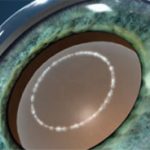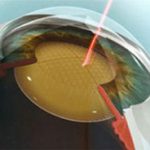Why Laser Assisted Cataract Surgery?
Cataract surgery is one of the most commonly performed procedures in Canada. Cataracts are the progressive hazing of the natural crystalline lens in your eyes and can cause decreased quality of vision.
Dr. Wiens has performed thousands of successful traditional cataract surgeries. Laser assisted cataract surgery provides a new level of precision and simplifies the already extremely successful and safe traditional cataract surgery.
What is Traditional Cataract Surgery?
Traditional cataract surgery begins with a small incision in your cornea (the window of the eye), allowing the surgeon access to the inside of your eye. Through this incision, a circular opening is made in the capsule of your cataract (manual capsulotomy). The cataract is then broken up with ultrasonic waves and removed – a process called phacoemulsification. After cataract removal, a lens implant is placed in your eye.
CATALYS™ Laser Assisted Cataract Surgery
While traditional cataract surgery is effective and successful, there are plenty of key advantages and benefits to choosing laser assisted cataract surgery (LACS). In reviewing the presently available technology, Dr Wiens has chosen the CATALYS™ femtosecond laser system, one of the most advanced systems available today.
Laser Assisted Cataract Surgery Procedure
Using the CATALYS™ system the procedure begins with a precise 3D image of your eye, which is carefully reviewed and approved by Dr. Wiens. These images will be the guide for your laser treatment.
 Next, focused laser energy creates a circular opening in the capsule of your cataract, called a laser capsulotomy. This ensures a precise location and accurately sized circular opening in your cataract’s capsule and in turn improves the central position of the lens implant.
Next, focused laser energy creates a circular opening in the capsule of your cataract, called a laser capsulotomy. This ensures a precise location and accurately sized circular opening in your cataract’s capsule and in turn improves the central position of the lens implant.
 The laser then creates a grid-like laser pattern within the cataract itself, as if it were cutting with an invisible blade. This process breaks the cataract up into small pieces, minimizing the amount of ultrasound energy needed. The cataract removal is then more efficiently done, decreasing the potential risk of damage to the cornea.
The laser then creates a grid-like laser pattern within the cataract itself, as if it were cutting with an invisible blade. This process breaks the cataract up into small pieces, minimizing the amount of ultrasound energy needed. The cataract removal is then more efficiently done, decreasing the potential risk of damage to the cornea.
Finally, Dr. Wiens uses the CATALYS™ laser to create the incision that allows access to the cataract. These incisions, created by the precise placement of laser energy, improves the consistency of incision size and location. This controls and minimizes changes in the surface of your cornea and helps maintain its natural round shape.
The CATALYS™ System also allows precise placement of incisions within your cornea, which are called arcuate Incisions. This technique may be used to help reshape your cornea from mildly oval to round and helps our team to treat a mild astigmatism. This may minimize your need for astigmatism correction in your glasses after your cataract surgery.
Images courtesy of Abbott Medical Optics
Key Benefits of Laser Assisted Cataract Surgery
Great Precision
The laser provides great precision and enables Dr. Wiens to make exact incisions to one tenth of a micrometer. For a real life comparison, a human hair is on average 85 micrometers wide.
Tissue Preservation
The advanced 3D imaging and highly developed software of the CATALYS™ System ensures that the laser impulses be delivered to only the designated treatment area, protecting the surrounding tissue.
Individual Customization
The CATALYS™ System creates a detailed 3D image of your eye, allowing Dr. Wiens to create an individualized treatment plan based on your specific needs.
Astigmatism
The CATALYS™ System is able to precisely place incisions within your cornea. This technique allows our team to treat your astigmatism by reshaping a mild oval cornea into a rounder shape. This may further reduce your need for astigmatism correction in your glasses after surgery.
Speed and Comfort
Each treatment is completely customized to your eye, increasing precision while reducing time required resulting in the laser treatment taking typically about 30 to 45 seconds. During the process, your eye is gently held in place with a soft suction ring that maximizes your comfort. From the initial placement of the suction ring until its removal, the total laser procedure is finished in less than 5 minutes.
